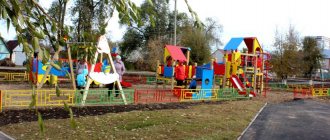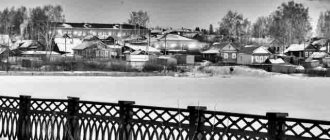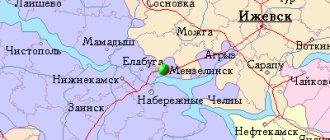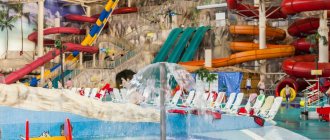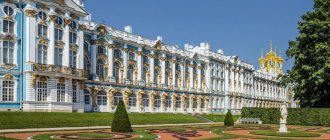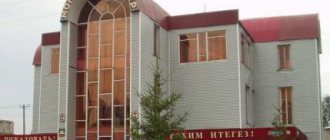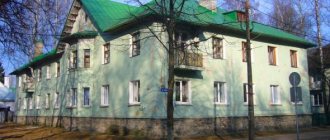General information and history of Balakovo
Balakovo is located in the Saratov region, northeast of Saratov at a distance of 176 km.
The first mention of the city dates back to 1738, at that time Balakovo was a Cossack possession - Balakov Yurt. According to the official version, the city of Balakovo was founded in 1762 by Old Believers, whom Empress Catherine II of Russia “strongly asked” to return from abroad to Russia and settle on the lands between the Bolshoy and Maly Irgiz rivers. Balakovo was a Volga village. City status was granted in 1911.
Balakovo from a bird's eye view
In 1936, Balakovo became part of the Saratov region; before that, the city was part of the Samara province. The formation of the final boundaries of the city and population growth were facilitated by the construction of the Saratov hydroelectric power station in the period from 1956 to 1971, which resulted in the flooding of part of the coastal territory. The Balakovo municipal formation was created in 1996, and in 2004 it was renamed the Balakovo municipal district.
Balakovo, the third largest city in the Saratov region (after, in fact, Saratov itself and Engels), is located on the left bank of the Volga. The city is approximately 200 kilometers away from the regional capital.
The building of the Alexandrov trading house
In pre-revolutionary Balakovo, in the Art Nouveau style, not only estates were built, but also trading houses, of which there were also plenty here, which is no wonder - the village (and since 1911 the city) was a trading place. To get acquainted with the pre-revolutionary trading houses of Balakov, let's walk a little along Zaovrazhnaya Street and turn left: onto Sovetskaya Street (formerly Nikolskaya). Three blocks later, at the intersection with 20 Let VLKSM Street (formerly Mariinskaya), our first goal.
Building number 59 is a former trading house. Some sources note that this is the former trading house of Alexandrov, but Alexandrov is indicated as the last owner, and the builder of this expressive building with an airy corner bay window topped with an elegant turret is named merchant A. A. Kuznetsov. Balakovo local historian Yu. Kargin, having studied archival documents, proved that there was a mistake with Kuznetsov and that this house was built by the same Alexandrov, who died in 1912. At the time of the owner’s death, the building housed a wine and gastronomic store, as well as clothing, shoe and hat stores. In the house, which has been well restored, which is, generally speaking, a rarity for Balakov, an ancient cast-iron staircase has been preserved.
Climate and ecology of Balakovo
The climate in the Balakovo region is characterized as moderate, which is typical for all settlements located in the Middle Volga. At different times, Balakovo residents saw both harsh winters with air temperatures of about −40, and sweltering summer heat, when the thermometer rose above 40 degrees.
Stella
As for the environment, this is one of the sore issues for residents of the Balakovo region. Representatives of giant enterprises like the Balakovo Nuclear Power Plant and the Saratov Hydroelectric Power Plant constantly convince residents that everything is normal and there is nothing to be afraid of, for clarity, periodically waving a Geiger counter and other instruments (the values on which, in the hands of nuclear scientists and other industrialists, naturally never exceed the norm) .
Ecologists, on the contrary, have been sounding the alarm for many years, talking about all kinds of emissions, pollution, and creating disappointing forecasts. The truth, most likely, is somewhere in the middle, but we can definitely say that Balakovo certainly cannot be called the cleanest city in the country.
Population of Balakovo
About two hundred thousand people live in the Balakovo region. If you believe official data, over the last five years there has been a downward trend in the population.
Representatives of all age categories live in the city. There are children, pensioners, students, and middle-aged people here. The population decline is mainly due to the fact that it has become almost a tradition for Balakovo youth to study, receive parental blessings and move away from the provincial town to the more glamorous and promising St. Petersburg or Moscow. Although it would be wrong to say that all young people are leaving the city en masse. Many remain.
Day of the city
The moral character of a typical Balakovo resident is hardly any different from the moral character of a representative of another provincial town. You can often hear the term “Bydlokovites” in relation to Balakovites. Moreover, it is interesting that this is what the Balakovites call their fellow tribesmen. This phenomenon can be found in local social networking groups.
To be fair, it is worth noting that such a nickname is to some extent justified. In Balakovo, the so-called “Sovkov legacy” is still alive, this is when an aunt-seller in a grocery store can say something like “What’s hatched, go ahead and order!”, and the conductor on the bus can swear at you for not having the amount to pay no change. This happens in Balakovo, and you need to be prepared for it. But in fairness, it is worth noting that there are still more sympathetic, polite people (of different ages) here.
Districts and real estate of Balakovo
Internally, the city is divided into three parts: island (residential town, old town and Dzerzhinsky village), canal (from 1 to 4 microdistricts and the village of Sazanley) and central (from 5 to 11 microdistricts and the village of Raduzhny).
Old city
The residential town is divided from the central and canal parts by a shipping canal, which divides the city, as it were, in half. There is only one bridge connecting the old part of the city with the new one (it is called the sluice bridge), which is not very convenient for the townspeople: during rush hours traffic jams often form on the bridge, and it takes a lot of time, for example, to come from the 11th microdistrict to the village of Dzerzhinsky .
Sluice Bridge
True, in the next year or two the problem should disappear. Balakovo residents will receive the long-awaited second bridge across the shipping canal. The first stone in the construction of the future bridge was laid at the beginning of the two thousandth under pompous speeches of local officials and Vyacheslav Volodin (then a deputy of the regional Duma, and now the vice-speaker of the State Duma). Since then, construction has been started, then frozen, and then unfrozen again years later. Fortunately, construction is now actively underway, and if you believe the promises of regional and local politicians, the bridge will be put into operation at the beginning of 2014.
New neighborhoods
The cost of apartments in the city of Balakovo does not “jump” much and remains approximately at the same level. A “one-room apartment” here, depending on the location of the house in which it is located, can be purchased from 800 to 1,500 thousand rubles. The price of a two-room apartment ranges on average from 1 million 200 thousand rubles to 2 to 2.5 million. Apartments in new areas (especially in new buildings in microdistrict 11) are more expensive than similar housing in other areas of the city. In general, housing prices in the central part of the city are higher than for apartments in the island part. Although in the residential city there are streets where apartments are considered more prestigious than in other parts of the city. These include Lenin Street and Torch of Socialism.
Border of the old town and residential town
In the village of Dzerzhinsky, which is located within the city, housing is cheaper. There are several reasons for this. Firstly, this is one of the oldest areas of the city, the housing here is mostly dilapidated. The infrastructure here is less developed than in other parts of the city.
In addition, the reluctance to purchase housing here is determined by the reluctance to communicate and generally encounter the local contingent. This is one of those areas where in the evening, if you don’t answer affirmatively to the question: “Hey, do you have anything to smoke?”, you run the risk of being beaten. This is one of the most crime-ridden areas of the city. Now things are somewhat better, but in the late nineties and early 2000s, gangs of teenagers operated here, lovers of the “green snake” sat on the benches, and those who served time and, ideally, “hit the hairdryer” were held in high esteem. Balakovo residents simply call Dzerzhinsky’s village “Dzerzhukha.”
The microdistricts of the canal part of the city (microdistricts 1, 2, 3, 4) are also considered not the most prosperous. The houses here are mostly in need of repair (except for the nine-story building on Kakhovskaya Street), and acts committed in apartments and on the streets of these microdistricts often end up in crime reports. Although it would be wrong to think that it is simply impossible to walk down the street here without a pistol or a stun gun in your bosom. It just so happens that these areas are considered less prosperous.
View of the nuclear power plant
Purchasing housing in microdistricts 5, 5A, 6, 7, 8, 8A, 9, 10 and 11 is more prestigious. They are considered central. The infrastructure here is more developed, the streets are cleaner and more well-groomed (as far as the terms cleanliness and well-groomedness are generally applicable to Balakovo). You can also find rental housing in Balakovo. On average, the monthly price for a one-room apartment ranges from 8 to 12 thousand rubles (depending on location). Prices for renting housing jumped significantly when non-resident workers arrived in Balakovo to build the Severstal Long Product Plant Balakovo enterprise. Demand creates supply, and the demand for rental housing with their arrival was simply frantic. Then prices increased one and a half to two times, and they remain at that level.
"Severstal - Balakovo Long-Product Plant"
Not far from the 7th microdistrict is the village of Raduzhny. It is fenced off from “mere mortals” and carefully guarded. This is a cottage community, where houses are mainly purchased by high-ranking nuclear scientists and other “owners of factories, newspapers, and ships.” To buy a house here, you need to have more than one million and, most likely, not even ten... Local residents call this village “Ipatovka”, in honor of the former director of the Balakovo Nuclear Power Plant and the former governor of the Saratov region, Pavel Ipatov.
Village "Rainbow"
"People = Balakovo." Vasily Chapaev is a legendary Balakovite!
The Balakovo Metallurgical Plant continues to talk about the people who glorified the city. The project is timed to coincide with the 260th anniversary of Balakovo; we will celebrate the anniversary in September. The first hero was a man whom everyone knows, without exception - Vasily Ivanovich Chapaev. This is what our story is about today.
Vasily Chapaev is a legendary personality not only for Balakov, but for the whole country. He is the most famous Red commander of the Civil War. There was no person who did not know who Vasily Chapaev was. Every city has a street named after him. In Balakovo, the memory of the famous countryman is honored very carefully; the city even preserves the house in which the Chapaev family lived. The house was small, unprepossessing, and seven people lived in it. Now there is a museum there, in which fragments of the life of a man who managed to become a legend are collected bit by bit. What he was like was explained by the museum guide Vasily Chapaeva, Olga Kruglova.
Looking for a better life
The large Chapaev family moved to Balakovo in 1896 from Chuvashia. At that time there was no city yet, but it was a large and rich village - the grain capital of the Volga region. They came here in search of a better life. They fled from hunger. Of the nine children, only five survived. Vasily Ivanovich’s younger brothers and sisters died in Cheboksary. After the death of their children, the parents decided to move to the grain-producing land of Balakovo, where they could feed their family. When they arrived here, it turned out that there had been a drought the day before. It hasn't rained for three years.
Life here was also very difficult. They walked around in bast shoes and homespun clothes. There was no bread, there was no work, there was no home. They were in need, lived with friends, some with others, saved on everything for three years, and then bought a house. The place where the museum is now located is the former outskirts of Balakovo, Sirotskaya Sloboda, where loaders, dray drivers, and the poor people of the village lived. The future commander spent his childhood and teenage years in the house, with a total area of 35 square meters.
“I won’t go to school anymore”
After moving to Balakovo, little Vasya went to a parochial school. He studied well, received only A's, but because of poverty he wore bast shoes. The boys often laughed at him, but he fought and did not let himself be offended. One day he came home from school and said to his father: “That’s it, dad, Khan!” I won't go to school anymore. Everyone there laughs at me because I’m wearing bast shoes.” No matter how much his father tried to persuade him, he never went to study again.
At the end of the twentieth century, museum staff managed to find out what happened then. One of the Balakovo long-livers said that it was not only because of poverty that Vasily dropped out of school. On September 1, when he was entering third grade, he came to school in a shirt, with a canvas bag over his shoulder and bast shoes.
The boys surrounded him and started laughing. One says: “Vaska Chapaev again, he came in bast shoes.” Another: “What are you saying, he has fashionable 24-check boots.” He pulled the string and the sandals came untied. Vasya ran after the offender. The bell rang for class and the teacher called everyone to the class. When the school day ended, the boy came home and said that he would not go to school again, this was his last straw, at which his patience burst. And he started working very early. His father was a carpenter. She taught her son carpentry.
Ermak is unsinkable!
Vasya Chapaev was 14 years old when he became a real assistant to his father. They then traveled on foot throughout the Saratov province: they built houses, churches, and custom-made furniture. There was big work, and there was small work. In the Pugachevsky district, a wooden church built by Chapaev has been preserved. A tragedy occurred there that could have deprived the world of a future red commander.
Vasya, as the fastest one, was asked by his father to climb up and put up a cross. The boy quickly climbed to the very top, put up a cross, walked away to admire whether he was standing level, stumbled and flew down. Everyone screamed in horror. If a person fell from above, he was killed. He was lucky to be alive. For which he received the nickname Ermak the unsinkable!
In Balakovo on Chernyshevsky, 112, the house built by the brothers Vasily and Grigory Chapaev has been preserved. Today this house is intact. You can come and see, people live there. And what’s interesting is that the owners know what kind of historical house they live in.
The museum of the legendary divisional commander preserves a wonderful cabinet made by Vasily Ivanovich Chapaev. It was manufactured in 1912. Found completely by accident in the 70s of the twentieth century. The Balakovo family donated it to the museum. The cabinet was made to order by the father of comrade Chapaev. The upper part has glass doors so that you can place beautiful dishes. Heavy silverware could be stored in drawers.
Years passed, that customer passed away. Vasily Ivanovich died at the front. I didn’t think it would end up in history. The sideboard has survived a lot and has survived to this day, and the most interesting thing: the glass in the upper part of the cabinet - it is unusual, with a wavy surface, made using a special technique and very fragile. If moved carelessly, it breaks into small fragments, like crystal. And this fragile glass has survived to this day.
Theater from Sirotskaya Sloboda
Vasily Chapaev was an unusual boy from childhood. He was considered a leader among the children of the Orphaned Settlement. The ringleader. The children who lived here chose him as commander in all games. They built snow forts and played snowballs. Well, then we grew up, and the games changed.
Who would have thought, but under the “leadership” of the young Vasya Chapaev, a folk theater was created in Balakovo. No, of course, these were not classical productions by Chekhov or Gogol, everything was much more prosaic. Boys from Sirotskaya Sloboda staged scenes from folk life about Styopka Razin, Ataman Kudeyar or Emelyan Pugachev. Sang songs. And the productions of folk theater, in every sense of the word, were successful not only with the common people, but also with richer people, merchants and industrialists. The guys were invited to restaurants, and some of their performances ended at almost six in the morning. The merchant's wife Zalogina went even further; she had a stage in her house to which she invited young actors, who performed on it with pleasure.
It all started with Christmas carols. The boys dressed up in sheepskin coats, with the fur facing out. And they went from house to house. They sang songs and caroled. The owners brought out pies or flatbreads and, at the same time, scenes from folk life were acted out.
Full Knight of St. George
Vasily Chapaev was the person who could lead people. His leadership qualities were also evident in the war. And now the time has come to take up arms and go to the front (the First World War began), where Vasily Ivanovich becomes a full Knight of St. George. Even the command singled him out. In a short time he immediately became a junior non-commissioned officer, then a senior non-commissioned officer, and rose to the rank of sergeant major. In 1915 he was awarded the St. George Crosses of the 4th and 3rd degrees, and the next year for courage and bravery he received the crosses of the 2nd and 1st degrees and became a full Knight of St. George. I also managed to receive a medal. He was unable to avoid injury and was hospitalized.
And then the revolution began, and another life began. He creates the Red Guard in the district and becomes the commissar of the entire Nikolaev district. He also had awards from the young Soviet government - this is the Order of the Red Banner of Battle. He had a high status - division commander, if compared with today, this rank can be equated to the rank of general.
The soldiers loved their commander, they believed in him and did not want to part with him. Even after serious injuries, they did not want to leave and were ready to fight without arms and without legs, to help their commander, whom they trusted infinitely, to end the war - so that people could live a peaceful and calm life.
Stories in photography
Several photographs have reached us showing the legendary commander - with friends, his wife, and colleagues. There are photographs of his father and his children. All of them are placed on the wall of his house-museum.
At the beginning of the twentieth century, photography was quite an expensive pleasure. The photograph of Chapaev’s father, Ivan Stepanovich, was preserved completely by accident. He moved his family to Balakovo more than 100 years ago. In the photo he looks sad and stern. The photograph of the father was preserved for a sad reason. He buries his youngest son Grigory Chapaev, the first military commissar of Balakovo, and a year later Vasily Chapaev also passed away.
There is a photograph in which the brave military man blinked because the shooting process was not fast. The next photo is of him with a friend, here he is in civilian uniform, a three-piece suit with a watch chain. According to recollections, the guy was fashionable and loved beautiful, stylish clothes. Vasily Ivanovich was a dapper guy. His hair was parted in the middle; he had a fashionable hairstyle, a butterfly. In the bottom row of photographs, Vasily Ivanovich stands with his wife Pelageya Metlina - this is a wedding photograph. There is a photo of Vasily Chapaev’s small children, who in 1922, after the death of their grandparents, were left orphans.
In 1909, Vasily Ivanovich got married. In 1910, his eldest son, Alexander, was born. He became a major general of artillery. Claudia was born two years later. Arkady, he was born in 1914, became a pilot. He died in 1939. He was only 26 years old.
The children loved the museum, this is their home, they were born here, they came here throughout their lives. Now, unfortunately, they are no longer alive. And while they were alive, at any time of the year they were very eager to come here, to Balakovo, because this was their homeland.
Legendary commander
Even after 135 years, Vasily Ivanovich remains the most famous Balakovsky resident. His name is well-known not only among the older generation, who with their eyes closed can tell the story of their legendary countryman, but also among young people. He built and loved our city. The boys laughed at him because he went to school in tattered bast shoes. But they did not go down in history wearing fashionable boots. Vasily Ivanovich entered and remained in it forever!
- Photo: © press service of the Balakovo Health Ministry
City infrastructure
The housing and communal services sector in Balakovo has always been one of the sore subjects. In recent years, problems have only increased. The dilapidated housing stock, the insolvency of public utilities, the uncleanliness of many Balakovo residents (they litter everywhere and a lot) are only a small part of the reasons why the communal services in the city are in a deplorable state.
Overflowing trash cans are a common sight
Prices for utilities are quite high compared to the quality of services provided. On average, a Balakovo resident pays from 4 to 5 thousand rubles monthly for a three-room apartment.
We should also talk about the condition of the roads. Bad roads are the scourge of the entire Saratov region. But the way things are with the roads in Balakovo was something that many residents of other settlements in the region never dreamed of. Sometimes they try to fix broken roads. Not even sometimes, but very often. But either the amounts allocated for repairs are being used up too actively, or these amounts are insignificant, but the fact is that the roads in the Balakovo region are in the worst condition.
The authorities try to correct the problem annually with so-called “pothole repairs”. This means that in the problem area they do not change the entire fabric, but patch up the holes point by point with material of questionable quality. As a rule, after some time the hole becomes deeper and wider than it was. True, in fairness it is worth noting that this year the situation has changed for the better. The authorities still found funds to repair a fairly large number of city roads. Most likely, this could not have happened without activist drivers, who this year wrote letters to the prosecutor’s office, regional authorities, and even the president demanding that the issue with roads in the Balakovo region be resolved.
Pothole repair
As for the provision of schools and kindergartens, there is order. There are 28 schools in the city. Naturally, there are problems (repairs, equipment), but in general everything necessary for the educational process is available. Yes, recently there was a problem with kindergartens. About ten years ago, offices and offices began to open en masse on the site of former kindergartens. The queue for kindergartens grew rapidly, almost reaching critical levels.
Thanks to the timely intervention of regional and local authorities and the sponsorship of some enterprises, it was possible to reconstruct and repair several kindergartens. This year, several renovated institutions opened at once. As a result, the queue for kindergartens began to rapidly decrease.
The building of the trading house of A. A. Schmidt
Finally, we definitely need to see the building of the trading house of A. A. Schmidt, which is one of the architectural symbols of the city. It is located on the corner of 20 Let VLKSM and Chernyshevsky (formerly Samara) streets. Construction - 1912, obvious Art Nouveau, one of the best examples of this style in Balakovo. The latter fact allows some authors to claim that F. Shekhtel took part in the design of the building, who was visiting Balakovo at that time to supervise the construction of the Trinity Church.
A. A. Schmidt was one of the largest traders in the Samara and Saratov provinces; he specialized in the sale of agricultural implements, textiles, haberdashery, and weapons. A list of goods presented in his Balakovo store has been preserved - among them: revolvers, hunting rifles, gunpowder, Singer sewing machines, Aitner bicycles, Badovsky mowers, Continental tires, Gargoyle gasoline and oil, etc. Internal the layout of the building, according to contemporaries, was reminiscent of the St. Petersburg “Passage” - the second floor was an open shopping gallery. The interiors of that time, unfortunately, have not been preserved, but the external appearance of the building has remained unchanged: the figured balcony, bay windows with turrets, the unusual “curvilinear” window of the northern facade and sculptures placed in niches are especially beautiful here: the characters of the sculptures were selected to emphasize the purpose of the building, - this is the god of trade Mercury, the goddess of hunting and fertility Diana, as well as the sower and the reaper.
Enterprises and work in Balakovo
Balakovo is an industrial city. First of all, it is worth mentioning two giants - enterprises of all-Russian significance: the Balakovo Nuclear Power Plant and the Saratov Hydroelectric Power Plant. These giants always worked stably, without blues and worries. Salaries at these enterprises are higher than the city average. But getting a job here without cronyism or connections is almost impossible. And although representatives of these enterprises claim that this is not so, the majority of Balakovo residents know very well that the positions of nuclear and hydropower engineers are filled “from father to son” or in other ways of family and friendship.
Balakovo NPP
Now in Balakovo the construction of the Severstal - Balakovo High-Products Plant is in full swing. It should start working soon. Officials talk about the fabulous sums that the enterprise will pay to the budget in the form of taxes, and residents are sounding the alarm, fearing for the already not-so-good environment. Other enterprises include (now going through hard times), Balakovo Mineral Fertilizers, Thermal Power Plant 4. In total, there are about 15 large enterprises and many medium and small enterprises in the city.
Saratov HPP
According to official data, the average salary in Balakovo is about twenty thousand rubles. However, in fact, most city residents receive 10-15 thousand rubles (many less). The average salary figure is this way because giants like nuclear power plants and hydroelectric power plants (where salaries are many times higher than at other enterprises and organizations in the city) are involved in the calculation. It’s like the joke: “My boss eats meat, and I eat cabbage, but on average we both eat cabbage rolls.”
Hotel and shopping complex of merchant A. V. Smirnov
We pass another block along Sovetskaya Street and on the right we see a complex of buildings facing Lenin Street. These two-story, solid houses were built, connected by a one-story “lintel” in the familiar brick style. This is one of the largest architectural ensembles of old Balakovo: a hotel and shopping complex of the merchant A.V. Smirnov. It was erected at the turn of the 19th and 20th centuries, when, as you might guess, there was a construction boom in Balakovo. In the main building of the complex there was a hotel on the second floor, and a store traditionally operated on the first floor. It is known about Alexander Vasilyevich Smirnov that in Balakovo he was highly respected for his business and human qualities. In addition, in the history of Balakov he remained as the first merchant to receive a guild certificate after the transformation of the village into a city (before such certificates were not allowed to be issued here). This happened in December 1914. Strictly speaking, it was Smirnov who became the first “official” Balakovo merchant.
Crime
The crime situation in the city can hardly be called difficult. Although weekly police reports contain information about thefts, robberies, and fraud. One of the high-profile cases, which was even reported on by central channels, is connected with a gang of “black realtors.” Gang members looked for lonely pensioners, socially disadvantaged people and arranged the “disappearance” of these citizens, criminally registering their real estate in the name of the right people.
Recently, the head (now former) of the Balakovo district administration also distinguished himself. He, taking advantage of his official position, made sure that one of his deputies received a three-room apartment (he even managed to privatize it). The court declared the official’s actions illegal and made a truly “strict” decision - he banned the culprit from holding leadership positions in government structures for two years.

